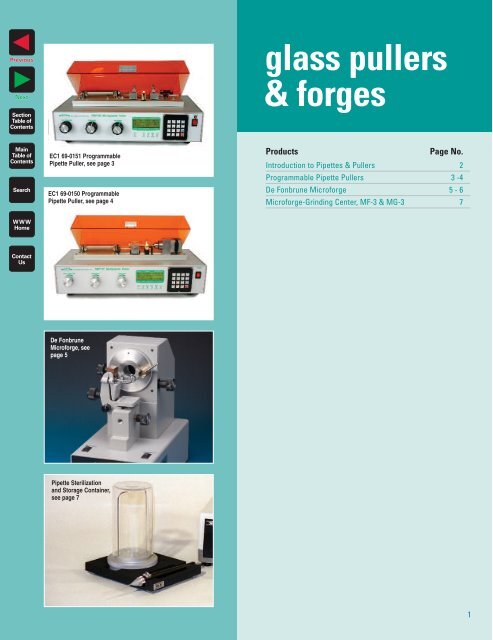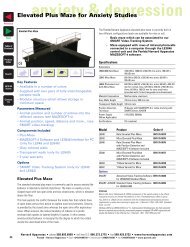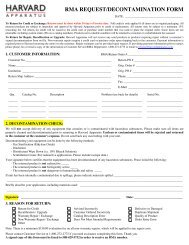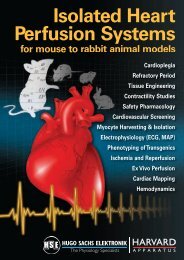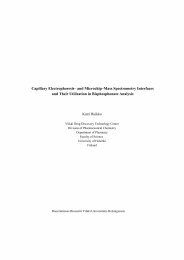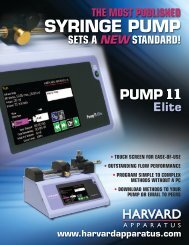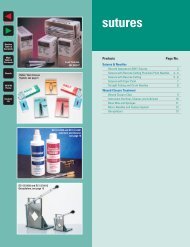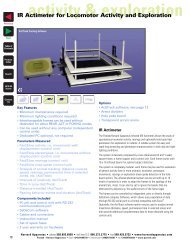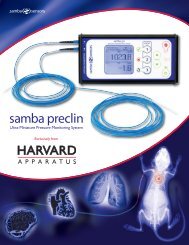Pipette Pullers - Harvard Apparatus
Pipette Pullers - Harvard Apparatus
Pipette Pullers - Harvard Apparatus
You also want an ePaper? Increase the reach of your titles
YUMPU automatically turns print PDFs into web optimized ePapers that Google loves.
glass pullers<br />
& forges<br />
EC1 69-0151 Programmable<br />
<strong>Pipette</strong> Puller, see page 3<br />
EC1 69-0150 Programmable<br />
<strong>Pipette</strong> Puller, see page 4<br />
Products<br />
Page No.<br />
Introduction to <strong>Pipette</strong>s & <strong>Pullers</strong> 2<br />
Programmable <strong>Pipette</strong> <strong>Pullers</strong> 3 -4<br />
De Fonbrune Microforge 5 - 6<br />
Microforge-Grinding Center, MF-3 & MG-3 7<br />
De Fonbrune<br />
Microforge, see<br />
page 5<br />
<strong>Pipette</strong> Sterilization<br />
and Storage Container,<br />
see page 7<br />
1
<strong>Pipette</strong> <strong>Pullers</strong><br />
pipette pullers<br />
A state of the art, microprocessor controlled horizontal pipette puller designed to simultaneously pull two identical,<br />
single barrel pipettes<br />
Needle micropipette fabrication devices include instruments<br />
intended to pull, bevel, or forge various types and styles of glass<br />
micropipette needles for ICSI, IVF, transgenics, patch recording or<br />
other similar procedures involving the use of micropipettes in<br />
electrophysiological recording, microinjection, and microperfusion<br />
techniques.<br />
The first step in the process involves the initial fabrication of the<br />
micropipette itself using either single or multibarrel capillary<br />
tubing. This tubing typically ranges in size from between 1 and 2<br />
mm OD and is usually made from borosilicate glass although other<br />
materials such as aluminosilicate or quartz are also used in some<br />
applications. The capillary tubing is then placed in a micropipette<br />
puller where a point on the capillary tubing is brought to its<br />
softening point through the use of a heating device such as an<br />
electrical filament, laser or gas flame. Once the capillary tubing’s<br />
softening point temperature is reached, a mechanical parallel<br />
pulling force is applied to each end of the capillary tube and it is<br />
‘pulled’ to the desired tip diameter and profile. Depending on a<br />
number of preset variables such as capillary material type,<br />
temperature, filament type and pulling force, numerous types of tip<br />
profiles and tip diameters can be fabricated. Using this technique<br />
tip sizes as small as 0.02 µm can be achieved. <strong>Pipette</strong> pullers can<br />
range in complexity from a simplistic spring/counter weight<br />
mechanical puller to highly sophisticated programmable<br />
microprocessor controlled pullers.<br />
To reshape the pipette or to fuse the tip into a different geometry,<br />
a microforge system is used. A microforge uses a heating element,<br />
microscope, illumination, micromanipulators and microtools to<br />
change the shape of or contact fuse other elements to the<br />
micropipette pipette by heating certain sections of the<br />
micropipette to either soften (for bending) or melting (fusing) the<br />
micropipette. Some types of microforges can also be fabricate<br />
metal and glass microtools.<br />
<strong>Harvard</strong> <strong>Apparatus</strong> manufactures and sells a complete range of<br />
high quality equipment and supplies to fabricate micropipettes.<br />
Programmable <strong>Pipette</strong> <strong>Pullers</strong>, see page 244<br />
Microforges, pages 246 to 248<br />
<strong>Harvard</strong> <strong>Apparatus</strong> • phone 508.893.8999 • toll free U.S. 800.272.2775 • fax 508.429.5732 • www.harvardapparatus.com 2
<strong>Pipette</strong> <strong>Pullers</strong><br />
Programmable <strong>Pipette</strong> <strong>Pullers</strong><br />
pipette pullers<br />
A state of the art, microprocessor controlled horizontal pipette puller for pulling single- or multi-barrel micropipettes<br />
EC1 69-0151<br />
• Two models available:<br />
– Single-barrel<br />
– Multi-barrel<br />
• Microprocessor controlled system performs<br />
programmable multiple step pulling sequences<br />
• Produces micropipettes for patch clamping,<br />
intracellular electrodes, injection micropipettes,<br />
micro needles, etc.<br />
• Consistent pulling force by utilizing pneumatic<br />
pressure instead of gravity or magnetic fields<br />
The PMP-102 is a state of the art microprocessor controlled horizontal<br />
pipette puller that has been designed to pull two identical single barrel<br />
pipettes at the same time. The pipettes can be used as patch clamp<br />
electrodes, intracellular electrodes, injection micropipette or microneedles.<br />
The PMP-107 is similar to the PMP-102, but is designed to pull a single 4-<br />
or 7-barrel pipette. Under program control, the PMP-107 can automatically<br />
heat, twist and pull a multi-barrel pipette. There is no need for any manual<br />
rotation or any inconsistent timing interrupt control.<br />
Exclusive Optical-Digital Taper Measurement<br />
Instead of a mechanical tip length setting as on other pipette pullers, the<br />
PMP-102 and PMP-107 use an exclusive optical-digital ruler to perform<br />
precise taper length setting, real-time measuring and controlling. With this<br />
feature, a user can handle the taper pulling of pipette tips precisely and<br />
very easily. Equipped with a powerful computerized tip sensing function,<br />
the PMP-102 and PMP-107 can automatically finish the tip pulling.<br />
Computerized Heater Control<br />
The PMP-102 and PMP-107 use an advanced microcontroller design to<br />
perform real-time heater monitoring and pulling control. Thus, they will<br />
always provide precise heating power, despite multiple/consecutive<br />
pipette pullings or changes in thermal/electrical characteristics.<br />
Programmable Sequences for Creation and<br />
Reproduction<br />
There are 25 user programmable pulling sequences with 18 steps in each<br />
sequence. Users can start the pulling sequence by just pressing the Start<br />
button.<br />
Factory Installed Preset Programs for Major<br />
Different <strong>Pipette</strong> Pulls<br />
Every pipette puller is pre-installed with a number of different pipette<br />
pulling programs. With just a few modifications to these steps or<br />
parameters new programs can be configured.<br />
Pneumatic Pulling Force<br />
Both pullers use a precise controlled pneumatic pressure as the pulling<br />
force rather than gravity or magnetic fields used by other manufacturers.<br />
This technique provides more controlled, even, and consistent dragging<br />
characteristics allowing the units to pull an ideal injection tip or<br />
microelectrode tip. A precision micro-linear ball bearing rail, and advanced<br />
pneumatic components are used to provide no fault pulling movement.<br />
Programming<br />
A simple 4x4 keypad and full information display allows the user to easily<br />
control and read all pulling parameters. Programming functions include<br />
sequences, steps, time, timing, heater level, heater control, and tip length<br />
and actions.<br />
These units are supplied with input tubing and connector, spare heater<br />
filament, tweezers, power cord and manual.<br />
<strong>Harvard</strong> <strong>Apparatus</strong> • phone 508.893.8999 • toll free U.S. 800.272.2775 • fax 508.429.5732 • www.harvardapparatus.com 3
pipette pullers<br />
<strong>Pipette</strong> <strong>Pullers</strong><br />
Programmable <strong>Pipette</strong> <strong>Pullers</strong> (continued)<br />
EC1 69-0150<br />
Specifications<br />
Pulling Force<br />
Multi-Barrel <strong>Pipette</strong><br />
Each Barrel <strong>Pipette</strong><br />
Heater<br />
Pneumatic<br />
4- or 7-barrel (EC1 69-0150 only)<br />
1 mm OD<br />
Nichrome coil<br />
Heater Control<br />
Microcontroller<br />
Heating<br />
74 general heat levels (24 to 99), 54 auto heat levels<br />
(45 to 98)<br />
Number of Sequences 25<br />
Steps in Each Sequence 18<br />
Taper Length Setting 0.5 to 20 mm<br />
Pressure 1 Regulator 0.1 to 10 p.s.i.<br />
Pressure 2 Regulator 0.1 to 60 p.s.i.<br />
Pressure Gas Input 30 to 60 p.s.i.<br />
Actions<br />
Pull 1, pull 2, pull 2/cool, rotation (EC1 69-0150 only),<br />
cool air, return<br />
Display<br />
20 x 4 LCD<br />
Power Input<br />
110/240 VAC<br />
Power Consumption Max. 150 W<br />
Dimension, H x W x D 17.8 x 27.9 x 35.6 cm<br />
Weight:<br />
EC1 69-0150 6.8 kg (18 lbs)<br />
EC1 69-0151 5.9 kg (13 lbs)<br />
Order # Product Price $<br />
EC1 69-0150 PMP-107 Programmable Multi-Barrel 11,118.00<br />
<strong>Pipette</strong> Puller<br />
EC1 69-0151 PMP-102 Programmable Single-Barrel 9,061.00<br />
Micropipette Puller<br />
EC1 69-0161 Unpulled 7-Barrel <strong>Pipette</strong> for EC1 69-0150 Only 25.00<br />
EC1 69-0162 Unpulled 4-Barrel <strong>Pipette</strong> for EC1 69-0150 Only 15.00<br />
<strong>Harvard</strong> <strong>Apparatus</strong> • phone 508.893.8999 • toll free U.S. 800.272.2775 • fax 508.429.5732 • www.harvardapparatus.com 4
<strong>Pipette</strong> <strong>Pullers</strong><br />
De Fonbrune Microforge<br />
pipette pullers<br />
De Fonbrune is the oldest and most respected name in microforging<br />
• Combines precise control of both movement<br />
and temperature<br />
• Fabricates microtools from simple probes to<br />
complex micro instruments<br />
• Multiple fabrication techniques allow<br />
forging/fabricating metals, alloys, organic<br />
crystals, polymers and other fusible materials as<br />
well as soda lime, borosilicate glass tubing and<br />
rod stock<br />
• Air jets provide ‘spot’ cooling of the heating<br />
element<br />
The De Fonbrune is the oldest and most respected name in microforging.<br />
This De Fonbrune-type microforge is the latest in a time-honored series<br />
based on Dr. De Fonbrune’s original device. It complements the precision<br />
applications of the de Fonbrune pneumatic micromanipulator, pipette<br />
pullers and microinjection systems by producing a wide variety of<br />
microtools adaptable to microbiological, cytological, genetic,<br />
microsurgical, microphysical and similar investigations and tools as<br />
precise as your procedure. It can be used to fabricate a wide range of<br />
microtools employing a variety of techniques either separately or in<br />
tandem: contact fusion or melting, distant or contact stretching,<br />
fracturing, microforging and microglass blowing. Employing a variety of<br />
movements and temperature controls which permit fabrication of<br />
microtools from simple to more complex micro-instruments such as,<br />
calibrated micropipettes, microscalpels, electrodes and micromanometers<br />
(for use in measuring devices for turgor pressure in single cells).<br />
This microforge is an optical-electrical forge system. For superior stability<br />
the entire optical-electrical forge assembly is securely bolted to the cast<br />
aluminum main housing. This housing contains the transformer, function<br />
switches and the operating controls for the adjusting filament temperature<br />
and light intensity. A circular disk, or mechanical stage, is mounted in front<br />
of the lamp housing. A pivoting spindle cylindrical vice with clamp for<br />
supporting the microtool being made is mounted at the periphery of this<br />
disk. Both disk and spindle may be rotated about their own axes and<br />
precision screws can adjust the entire assembly vertically or horizontally.<br />
The light intensity directed to the microscope objectives may also be<br />
adjusted. The electrical forge sub-assembly is mounted on an adjustable<br />
electrode holder system directly in front of the microscope objectives and<br />
to the left of the microtool being fabricated. The spring-loaded filament<br />
holder provides for easy insertion or replacement of the platinum-iridium<br />
(or other filament material) forge element. The vertical and horizontal<br />
position of the heating element can be precisely controlled by the two<br />
controls mounted on the operating head and main electrode casting. Two<br />
controls on the stage are used to position the vertical and horizontal<br />
movement of the microtool.<br />
The electrode holder can be positioned either vertically or horizontally and<br />
can easily be replaced. The electrode holder and heating filament can be<br />
pivoted as a unit horizontally in a short arc, causing the electrode to move<br />
parallel to the optical axis about 1 ⁄2 inch. Two curved air jets are also<br />
mounted on the adjustable holder system and are equipped with an<br />
adjustable valve. These jets direct airflow to the wire-heating filament to<br />
provide ‘spot’ cooling of the heated element. Adjusting the current to the<br />
electrode controls filament heat. The heat at a given setting will vary<br />
depending on the size and type of filament wire, the amount of air blown<br />
against the filament and the amount of heat conducted away from the<br />
filament by the tool.<br />
The system is supplied with platinum/iridium wire for the electrode and<br />
has the ability to utilize other types and gauges of forging filaments. The<br />
apertures of the electrode pins will accommodate up to 22 gauge (0.0253<br />
inch diameter) filament wires. The following items are also included with<br />
the system: 4 microtool reamers, wax inducing instrument, capillary glass<br />
tubing, hammering rod, 3 sticks sealing cement, 4 80 mm microtool<br />
holders, 15-watt bulb, weight set (0.5 to 17 gm in 1 gm increments), 31 ga<br />
heating element wire, 1 pkg. 2 x 150 mm pyrex glass rod, forceps and 2<br />
angular microtool holders.<br />
<strong>Harvard</strong> <strong>Apparatus</strong> • phone 508.893.8999 • toll free U.S. 800.272.2775 • fax 508.429.5732 • www.harvardapparatus.com 5
pipette pullers<br />
<strong>Pipette</strong> <strong>Pullers</strong><br />
De Fonbrune Microforge (continued)<br />
Fabrication Examples<br />
A. Cupping glass:<br />
Bent at an angle for<br />
positioning in a<br />
moist chamber.<br />
B. Three types of<br />
cupping glasses:<br />
(a) rounded tip,<br />
(b) rounded tip slightly<br />
constricted, (c) blown<br />
cupping glass.<br />
C. Orifices of capillary<br />
tubes: (a) Sharp edge,<br />
(b) Smooth edge,<br />
(c) Constricted orifice.<br />
D. Local constrictions of<br />
a capillary tube:<br />
A circular (a) or<br />
elongated (b) orifice<br />
is formed within the<br />
capillary.<br />
E. Spatula: Piece of<br />
triangular glass whose<br />
corners have been<br />
fire polished and then<br />
affixed to a glass rod.<br />
F. Various types of<br />
micro-needles; with<br />
plain and pediculated<br />
points. Hook and<br />
needle with eye.<br />
G. Retaining hook. H. Different types of<br />
micro-pipettes: (a, b,<br />
c) terminal orifice;<br />
(d and e) lateral<br />
orifice.<br />
I. Piercing a Glass<br />
Wall: a, a’, projecting<br />
tips; b, b’, flat tip; c,<br />
passage of a metal<br />
wire through an<br />
aperture as a’; then<br />
sealing it by fusion.<br />
A flat plane may be<br />
perforated in the same<br />
manner.<br />
J. Type of Scalpel: A<br />
small globule of glass<br />
is affixed to filament.<br />
Then a platinum wire<br />
embedded in a glass<br />
capillary enters the<br />
surface of the heated<br />
glass. The heat is<br />
turned off; instrument<br />
pulled away from a<br />
circular cutting edge.<br />
K. Spatula loop: Light<br />
coming through the<br />
opening is darkened by<br />
a small film of<br />
transparent lacquer.<br />
L. Micro-gauge: The<br />
horizontal portion of<br />
this gauge is made<br />
with a hollow cylinder.<br />
M. Probe (a) and<br />
cannula (b).<br />
Specifications<br />
Tool Movement:<br />
Vertical<br />
Horizontal<br />
Electrode Movement:<br />
Vertical<br />
Horizontal<br />
Focus<br />
Weight<br />
Dimensions, H x W x D<br />
Power<br />
12.7 mm (~0.5 in)<br />
10.1 mm (~0.4 in)<br />
7.6 mm (~0.3 in)<br />
15.2 mm (0.6 in)<br />
12.7 mm (~0.5 in)<br />
17.25 kg (38 lbs)<br />
38.1 x 27.9 x 40.6 cm (15 x 11 x 16 in), without optics<br />
100/120 VAC, 60 Hz, 220/240 VAC, 50 Hz<br />
Order # Model Product Price $<br />
EC1 69-0384 MF-1-115 Microforge without Optics, 6,623.00<br />
115 VAC, 60 Hz<br />
EC1 69-0438 MF-1-230 Microforge without Optics, 6,839.00<br />
230 VAC, 50 Hz<br />
EC1 64-1700 MDF-1 Microscope for DeFonbrune 1,749.00<br />
Microforge includes microscope<br />
and adapters<br />
Order # Model Product Price $<br />
Replacement Parts<br />
EC1 69-0387 MF-4 Hammering Rod, SS 3 ⁄16 x 3.75 in 14.00<br />
(95 mm) (D x L)<br />
EC1 69-0388 MF-5 Bulb, Frosted for Microforge 49.00<br />
Illuminator<br />
EC1 69-0389 MF-6 Tool Holder Clamp 75.00<br />
EC1 69-0390 MF-7 Fuse, ACG 5, 1 ⁄4 x 1- 1 ⁄4 in 4.00<br />
EC1 69-0391 MF-8 Filament Wire, Platinum, 22.00<br />
20% IRID, 102 mm (4 in) L,<br />
31 ga, 229 µm (0.009 in) OD<br />
EC1 69-0392 MF-9 Filament Wire, Platinum, 22.00<br />
20% IRID, 102 mm (4 in) L,<br />
30 ga, 305 µm (0.012 in) OD<br />
EC1 69-0448 AK15 Glass head pipettes, 3 mm OD, 51.00<br />
pkg of 100<br />
EC1 69-0394 MF-11 Accessory Kit without weights 254.00<br />
EC1 69-0395 MF-12 Filament Holder Assembly with 529.00<br />
Center Rod, 6.4 x 51 mm<br />
(0.25 x 2 in) (OD x L)<br />
<strong>Harvard</strong> <strong>Apparatus</strong> • phone 508.893.8999 • toll free U.S. 800.272.2775 • fax 508.429.5732 • www.harvardapparatus.com 6
pullers<br />
<strong>Pipette</strong> Sterilization and Micropipette<br />
Pre-pulled<br />
Blank<br />
Fully-pulled<br />
Micron tip<br />
• Easy filling<br />
• Minimal tip resistance<br />
• Minimal leakage<br />
• Available pre-pulled or fully-pulled<br />
7-Barrel Iontophoresis Micropipette<br />
• Ideal for dry heat sterilization of pipettes<br />
• Pyrex-type glass covers make contents easily<br />
visible<br />
• Holds 21 pipettes<br />
• Available for 1.0, 1.2, 1.5 and 2.0 mm diameter<br />
pipettes<br />
<strong>Pipette</strong> Sterilization and Storage<br />
Container<br />
This container is a convenient and easy to use pipette storage container. It<br />
is ideal for both storage and dry heat sterilization of micropipettes. In most<br />
application pipettes must be free from contamination at all times. By<br />
storing completed pipettes and partially made pipettes (between<br />
operations), the cleanliness of the micropipettes can be assured. Because<br />
the covers are made of Pyrex glass, the complete container with pipettes<br />
in-situ can be dry-heat sterilized, ensuring contamination-free pipettes.<br />
The base accepts 21 pipettes. Select from containers holding either 1.0,<br />
1.2, 1.5 or 2.0 mm OD pipettes.<br />
Order # Product Price $<br />
EC1 69-0114 <strong>Pipette</strong> Sterilization and Storage Container for 222.00<br />
1.0 mm <strong>Pipette</strong>s<br />
EC1 69-0316 <strong>Pipette</strong> Sterilization and Storage Container for 199.00<br />
1.2 mm <strong>Pipette</strong>s<br />
EC1 69-0317 <strong>Pipette</strong> Sterilization and Storage Container for 222.00<br />
1.5 mm <strong>Pipette</strong>s<br />
EC1 69-0318 <strong>Pipette</strong> Sterilization and Storage Container for 199.00<br />
2.0 mm <strong>Pipette</strong>s<br />
The MS-7P Micropipette has been designed for iontophoretic use as well<br />
as for pneumatic ejection of drugs. The standard blank consists of seven<br />
barrel, pyrex Omegadot tubing, 1.5 mm outer diameter and 1.2 mm inner<br />
diameter, pre-pulled to 2.0 mm formation as shown. The design of the<br />
micropipette readily lends itself to electrical connection by inserting Ag<br />
wire or to pressure tube attachment for pneumatic use. The overall length<br />
of the blank assembly is 10 centimeters. The micropipette is supplied as<br />
either pre-pulled blanks or fully-pulled to a micron tip as shown. The<br />
micron tip is not bumped and therefore can be finalized prior to use.<br />
Features<br />
• The orifice ratio of each barrel is 0.80 and thus is<br />
optimized for minimal tip resistance when pulled<br />
to micron size.<br />
• Omegadot tubing permits easy filling.<br />
• Fanned-out outer barrel assembly provides<br />
separation thus avoiding leakage due to spills and<br />
any cross-coupling between barrels.<br />
• The 22 mm long twisted segment of the blank<br />
assembly assures singular tip formation during<br />
pulling action thus<br />
provides flexibility in a selection of a desired tip<br />
configuration.<br />
Order # Model Micropipettes Price $<br />
EC1 65-0207 MS-7PB Micropipette 7-Barrel, 425.00<br />
1.5 mm OD Borosilicate Glass,<br />
Pre-Pulled Blank, pkg. of 20<br />
EC1 65-0208 MS-7MT Micropipette 7-Barrel, 310.00<br />
1.5 mm OD Borosilicate Glass,<br />
Fully-Pulled, approx. 20 µm Tip,<br />
pkg. of 10<br />
<strong>Harvard</strong> <strong>Apparatus</strong> • phone 508.893.8999 • toll free U.S. 800.272.2775 • fax 508.429.5732 • www.harvardapparatus.com 7


